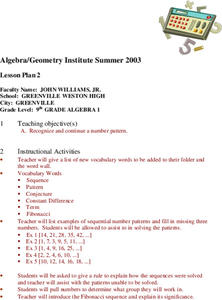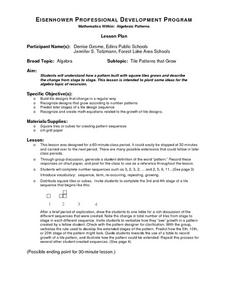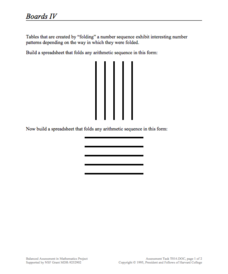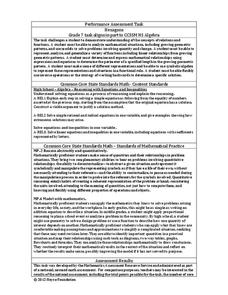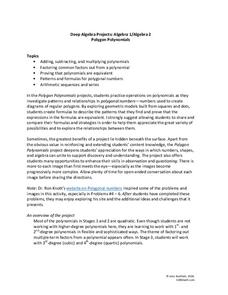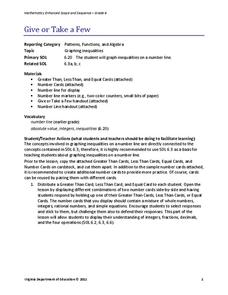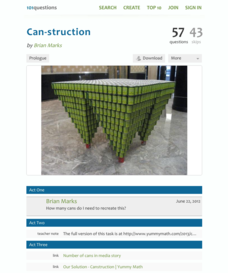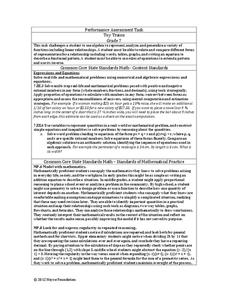Curated OER
Multiples 4
In this recognizing multiples worksheet, students observe patterns of x's and draw the next sequences, write the number of crosses in the patterns and determine the rules for the sequences, and solve an exponent problem. Students solve...
Curated OER
Repeating and Growing Patterns homework 6.5
In this continuing the pattern worksheet, students observe patterns, write the numbers, draw the next picture, and identify sequence as a repeating pattern or a growing pattern. Students write four answers.
Math Salamanders Ltd.
Counting on by Digits Sheet 2
In this number sequence activity, learners fill in 40 missing numbers in sequence on 10 different number lines. Students calculate each single-digit step up for each one.
Curated OER
Creating, Describing, and Analyzing Patterns
Students investigate patterns. In this kindergarten through second grade mathematics lesson, students use patterns to analyze relationships and make predictions. Students use an interactive math applet to investigate repeating and...
Curated OER
Find a Pattern problem solving 6.6
In this finding a pattern using a table worksheet, students write what they know and need to find out, make a table to show a pattern, and solve the pattern sequence. Students write nine answers.
Curated OER
Patterns and Sequences
Ninth graders examine sequential number patterns and the Fibonacci sequence. Given number patterns, they determine the next number in a sequence. Students develop their own number patterns and exchange them with another to be solved.
Curated OER
Tile Patterns that Grow
Students explore how a pattern built with square tiles grows and describe the change from stage to stage. They predict later stages of a tile design sequence and create math equations related to the growth of tile designs.
Curated OER
Searching For A Pattern
Students investigate the concept of number patterns. They practice recognizing various forms of them. Students solve different problems using multiples of different numbers. The multiples are then explained to be in a sequence.
Curated OER
Practice With Patterns
In this pattern worksheet, students explore sequence of numbers. They identify the next number in a sequence. This one-page worksheet contains 30 problems. Students may check their answers online.
Curated OER
Fibonacci Sequences Icebreaker
Students explore Fibonacci sequences. In this math lesson, students identify the relationship between two numbers. Students use Fibonacci sequences to create algebraic equations.
Curated OER
Patterns: A Stitch in Time
Students recognize shapes, designs and numbers that form patterns. Using their surroundings, they identify common patterns. They create their own patterns in various software programs and share them with the class.
Curated OER
Finding The Sequence
In this math worksheet, students look for the numbers that are used to complete the sequence of numbers. They also write down the rule for the 20 questions.
Curated OER
Starfish Surprises
In this missing numbers worksheet, students write the missing numbers covered by the starfish in the patterns. Students complete 6 problems total.
Concord Consortium
Boards IV
Build a connection between algebraic sequences and spreadsheets. Learners examine a specific folding pattern and convert the pattern into a spreadsheet. The goal of the spreadsheet is to produce a sequence of a specific pattern modeled...
Inside Mathematics
Conference Tables
Pupils analyze a pattern of conference tables to determine the number of tables needed and the number of people that can be seated for a given size. Individuals develop general formulas for the two growing number patterns and use them to...
American Museum of Natural History
DNA Detective
DNA is like the fingerprint of genetics. A quick lesson introduces the topic of DNA sequences with a mystery about an endangered species. The lesson shows how DNA extraction, replication, and sequencing often provide undeniable evidence...
Inside Mathematics
Hexagons
Scholars find a pattern from a geometric sequence and write the formula for extending it. The worksheet includes a table to complete plus four analysis questions. It concludes with instructional implications for the teacher.
EngageNY
Successive Differences in Polynomials
Don't give your classes the third degree when working with polynomials! Teach them to recognize the successive differences and identify the degree of the polynomial. The lesson leads learners through a process to develop an understanding...
5280 Math
Polygon Polynomials
Patterns in polygons lead to patterns in polynomials. Presented with a series of polygons, individuals create polynomial expressions to represent their patterns. The algebra project consists of nine problems that incorporate polynomial...
Virginia Department of Education
Give or Take a Few
Young mathematicians extend their knowledge of rational numbers on a number line to graph inequalities by first using number cards to compare rational numbers. They finish by using similar reasoning to graph inequalities on a number line.
101 Questions
Can-struction
Can you solve it?! A New York City art challenge involves making sculptures from cans. The task is to determine the number of cans used in the engineering award-winning sculpture. Scholars consider the patterns in the different layers to...
Mathematics Vision Project
Module 4: Linear and Exponential Functions
Sequences and series are traditionally thought of as topics for the pre-calculus or calculus class, when learners are figuring out how to develop limits. But this unit uses patterns and slopes of linear functions in unique ways to bring...
Noyce Foundation
Toy Trains
Scholars identify and continue the numerical pattern for the number of wheels on a train. Using the established pattern and its inverse, they determine whether a number of wheels is possible. Pupils finish by developing an algebraic...
West Contra Costa Unified School District
Arithmetic Series
Fall for a series. Learners determine how to find out how far a skydiver falls in the first 20 seconds. The Algebra II lesson introduces the idea of adding up the terms of an arithmetic sequence. Pupils learn how to use Sigma notation to...







